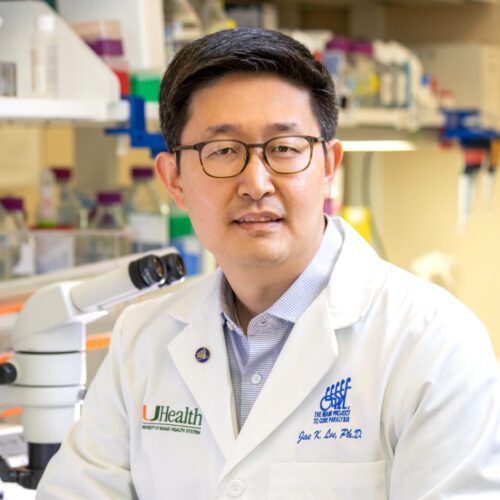Jae K. Lee, Ph.D.
Christine E. Lynn Distinguished Professor in Neuroscience
Professor, Department of Neurological Surgery

The Miami Project to Cure Paralysis
1095 NW 14th Terrace (R-48)
Miami, FL 33136
Biography
Research Interests
Areas Of Research
Publications
More
Dr. Jae Lee received his BS from George Washington University in 1997 and his Ph.D in Neuroscience from Georgetown University in 2005. He completed his dissertation research in Dr. Jean Wrathall’s laboratory investigating plasticity of local reflex circuits after spinal cord injury. He continued his interest in spinal cord injury research as a postdoctoral fellow in Dr. Binhai Zheng’s laboratory at UCSD where he investigated the role of myelin-associated inhibitors and chemorepulsive axon guidance molecules in inhibition of axon regeneration. He started his faculty position at The Miami Project to Cure Paralysis, University of Miami School of Medicine in 2011 where he is currently investigating mechanisms of scar formation after CNS injury.
Glial and Fibrotic Scar Formation in the CNS; Axon Regeneration
After traumatic injury to the central nervous system (CNS), such as spinal cord injury or traumatic brain injury, non-CNS cells such as hematogenous immune cells and fibroblasts enter the CNS parenchyma and cause tissue damage. In response, glial cells attempt to form a protective barrier but during this process, these reactive glial cells (often called the glial scar) create an environment that is not conducive to tissue repair. The primary goal of our laboratory is to investigate how these CNS and non-CNS cells interact to form the scar in hopes that a better understanding of this complex process will help promote cellular repair and axon regeneration.
Toward this goal, we are currently investigating the molecular and cellular mechanism of glial and fibrotic scar formation after neurological disorders such as spinal cord injury. A hallmark of many CNS pathology is the presence of hypertrophic reactive astrocytes. This is especially true in cases of traumatic CNS injuries where a dense network of interweaving hypertrophic reactive astrocytes surround the injury site. However, another major cellular component of this glial scar is NG2 cells (a.k.a oligodendrocyte progenitor cells or polydendrocytes) that are commonly overlooked. We are currently investigating the contribution of NG2 cells to glial scar formation
In addition, we are also investigating the role of fibroblasts that invade the injury site after spinal cord injury. Although the glial scar has received a lot of attention, very little is known about the fibrotic scar after CNS injury. While the traditional view was that fibroblasts originate from the meninges that surround the brain and spinal cord, our findings identified perivascular fibroblasts as a major source of the fibrotic scar after spinal cord injury and that this process is mediated by hematogenous macrophages. We are currently investigating the role of the fibrotic scar in CNS disorders and the contribution of macrophages to scar formation.
Visit Dr. Lee’s Publication Listing
News Stories
Miami Project Researcher Receives $6 Million NIH Grant (August 2023)
NIH/NINDS Blueprint Neurotherapeutics Network Grant (April 2022)
Miami Project Researchers Publish on Wound Healing in JEM (June 2021)
Dr. Dalton Dietrich and Colleagues Receive $1.6 Million NIH Award (06/30/2016)
New Axon Sprouting Research Findings Published (11/09/2014)
Researchers Receive New Defense Funding for Axon Regeneration and Spinal Cord Injury Research (June 2013)
PROFESSIONAL AFFILIATIONS/MEMBERSHIPS
Society for Neuroscience
